M2- Buyer Personas
What you will learn: What buyer personas are, why they are useful and how to create them.
Task: You will create buyer personas for your products/services.
Read Time: 17 minutes
Task Time: Half hour or more. The time depends upon how many products/services you have, how well you know your current customers and the level of detail you desire.
What are buyer personas?
Buyer personas are fictionalized representations of your ideal clients. For example, if you sell yoga pants, your buyer personas might look like this:
Marcy, the single executive

Personal background: Single, 35 years old, lives in Manhattan.
Business background: Went to NYC for undergrad, has a law degree from Hoftra University and is a member of the New York Bar Association. Co-founded a private equity firm based in New York City. Travels frequently in the US for work.
Lifestyle: Works very long hours. Her social life is mostly confined to colleagues and family. She is so tired and stressed from working long hours that she spends most of her weekends at home. She focuses on self care. She has regular blow drys, manicures and pedicures. She practices yoga either at home via online videos or with a private yoga instructor. Marcy also goes to the gym or runs once or twice per week.
Where she goes for information: Marcy does not use Facebook. Occasionally, she consults Twitter, Instagram and Pinterest. Most of her information comes from traditional media, watching TV and browsing the internet while shopping online.
Pain points: Money is not a concern for Marcy. Her problem is lack of time- she rarely has time to shop, which is why she purchases online. Her lack of social life and a partner is something that upsets her a lot.
Catherine, the stay at home mom

Personal background: Married with two teenage daughters, 49 years old, lives in Northern California.
Business background: Has an undergraduate degree from the Rhode Island School of Design in historic preservation. Works part time in education. Her husband has a solid career as a real estate agent.
Lifestyle: She is very focused on her kids, who are 15 and 12 years old. Spends a lot of time taking her kids to their various activities, shopping and cooking for her family. Catherine has practiced yoga for years, which she does in a studio setting. She also regularly hikes and runs. Catherine is very focused on environmental awareness and living a healthy lifestyle.
Where she goes for information: She does not use social media, with the exception of Pinterest. Most of her information comes from fellow moms, yoga studios, mommy blogs and environmental blogs.
Pain points: Although her husband makes good money, he works on commission and they live in a very expensive part of the world, so she is budget conscious. She often spends so much time focusing on her family that she neglects her own needs.
Maria, the working mom

Personal background: Married with two young children, 29 years old, lives in the Boston suburbs.
Business background: Maria has a law degree from Boston University and is a member of the Massachusetts Bar Association. She is a corporate attorney for a large health insurance company.
Lifestyle: Maria is very focused on her job and works relatively long hours. Her husband is a school teacher so he spends a lot of time with the kids and cooking meals. She goes to the gym regularly and also takes studio yoga classes.
Where she goes for information: Maria is not very active on social media, with the exception of LinkedIn. She is an avid reader of online news, where she is frequently served ads targeted to her demographic. She does a lot of product research before she purchases anything.
Pain points: Although she is not particularly budget conscious, her husband is. As she is very busy with work, she doesn’t have much time to shop except during her lunch break at work. She would prefer to spend more time on self care, and has the budget for it, but is often worried about upsetting her husband.
Why are buyer personas useful?
Buyer personas help you get in touch with your potential customers. Because they are characters, you can start relating to them as human beings. This enables you to learn how they act, where they might find out about your product, where, when and why they shop.
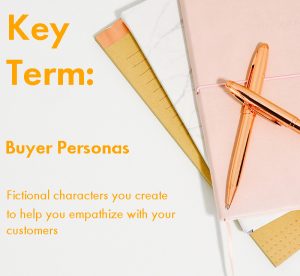
Depending upon your marketing and advertising budget, you can construct marketing/advertising campaigns to appeal to each individual buyer persona, or look for commonalities in them all. For example, looking at the above buyer personas, we know that they are all:
‣ In their late 20s or 30s.
‣ Are all well educated.
‣ Reasonably to very affluent.
‣ Are all very busy but still make time for self care.
‣ Do other physical activities in addition to yoga.
‣ Spend a lot of time on the internet, but not on social media.
Now, let us pretend we need to make a marketing strategy for this yoga pants manufacturer. The information gleaned from these buyer personas is extremely valuable. They tell us that price is not a key factor when our buyer personas shop. We also know that our styles need to appeal to a younger demographic.
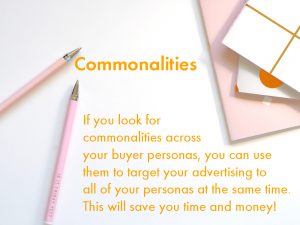
The buyer personas give us even more information when we construct our digital marketing strategy. We know that our personas don’t use social media much, but they are all very active on the internet. We also know they don’t just practice yoga- they do other sporting activities. Moreover, they are all well educated. From this, we can draw conclusions and craft a strategy.
First, since none of them are active on social media, but they do use the internet, we know we have to use either paid search or SEO if we want to reach them. Second, we have a lot of information to guide our key phrase research. We know we can use keywords broader than just yoga: general fitness, self care, health and nutrition, time saving hacks. And, we know that we have to use key phrases with a broad national reach: local search won’t cut it. Third, we know they are all well educated, so we should craft our content accordingly.

How to make buyer personas
Big corporations spend tens of thousands of dollars researching and creating their buyer personas. But this course is made for small and medium sized business owners, so we’re going to use a few simple hacks to create accurate buyer personas on a budget constrained by both money and time.
Our first hack is to use your best customers, the ones that continually purchase your products and services and refer them to others, as your buyer personas.
If you don’t have enough information about these people, we are going to learn to use Google Analytics and social media to create your buyer personas.
Task
Your task is to complete this Buyer Persona Worksheet. Follow the steps below to do so.
Step 1
First, consider the products and/or services you offer to people. Now, think about who currently buys those products and services. Ask yourself: Do the same types of people purchase all my products and services, or do they appeal to different demographics? If they appeal to different demographics, start by focusing on your product/service that is your biggest money maker. You can do the others later, but let’s focus on the most important one for now.
Step 2
Think about your best customers. Do they represent your average customer profile? You may have a few outliers, but you can probably think of 2-3 of them that are representative. If you know them well enough, you likely have enough information to create your buyer personas, based on these real people. That may sound simplistic, but that is what I did in the above example. I thought of three people I know who buy a lot of Lululemon workout clothes. I wrote down the information for each and looked for commonalities.
I took this information and used it to create a strategy:
1–I determined the yoga pant maker should prioritize SEO.
2–I determined that key phrase topics could include general fitness, self care, health and nutrition and time saving hacks.
3–I determined that key phrases must have national reach.
Then, I had a look at one of my favorite tools (I will unveil this tool in Module 3) that allows me to spy on how much website operators spend on paid search and SEO. I typed in Lululemon, and here is what I discovered:
‣ Lululemon spends $351 thousand per month on paid search.
‣ Lululemon spends $2.47 million a month on SEO.
‣ They use key phrases related to other health and fitness topics.
‣ If you search on the key phrase Lululemon blog, the query yields pages of results of third party blogs dedicated to Lululemon. There is even a site with the Top 10 Lululemon blogs! These sites all blog on broader topics such as fashion, beauty, shopping, fitness, health and activewear.
This demonstrates that creating buyer personas based upon a few known customers enables us to draw some very accurate conclusions. So if you know your customers well, that information should be sufficient to get you started. This is a big advantage small and medium size businesses have over larger ones- you are likely to know your customers much better because you deal with them on multiple levels.

If not, you are going to have to do further research.
Step 3
If you have a good idea of who your general customers/clients are, but don’t know them well enough personally to complete the template, the best thing to do is arrange a few interviews with them. Most people are more than willing to help a brand they are loyal to- especially if you offer them a small incentive.
Once you arrange your interviews, prepare a list of questions to ask them. To make it easy, you can use the questions on the buyer persona worksheet.
Use the answers to these questions to complete your Task.
What if you don’t have that kind of contact with your customers? Then you will need to proceed to Step 4.
Step 4
Our second hack is to use data from Google Analytics to create your buyer personas. Log in to Google Analytics. On the left hand column, under Reports, you will see Audience. Click on that:
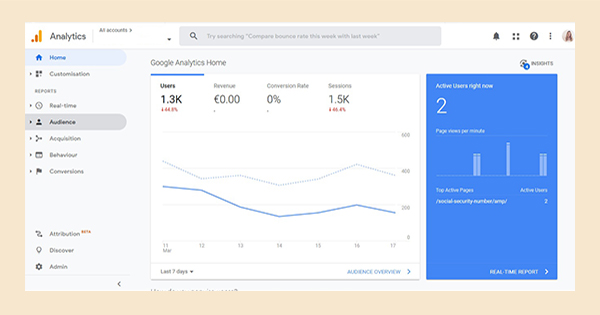
Now, scroll down to Demographics and click on Overview. You will see some initial data, like this:

For this client (it’s different than the Lululemon example), I can learn two things right away: 42.29% of their web traffic is from people aged 25-34. 18.48% of their web traffic comes from people aged 35-44. These two demographics combined make up 60% of their web traffic. The rest of their website traffic is relatively evenly distributed among the remaining demographics.
We can also see that their web traffic is evenly split between men and women.
Now, go back to the left column, click on Geo and then Location. This tells us that 27.42% of their web traffic comes from Spain, 16.61% from the US and 11.76% from the UK. The rest of the traffic comes from European countries, but is a much smaller percentage of traffic, so we can move on.
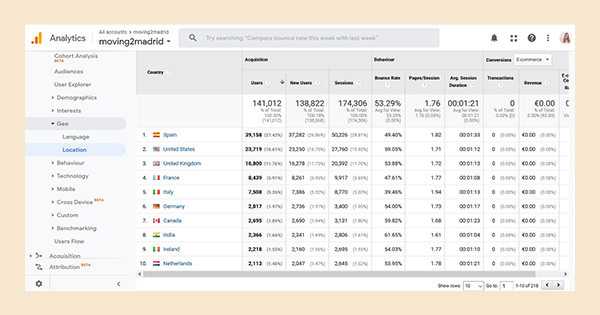
Now, go back to the left column and click on Interests, Overview then In-Market Segments. This gives us more valuable information. We learn that almost 7% of web traffic comes from people that have done searches on travel related products, 5% have done research on getting new jobs, another 6.2% of them have done research on real estate and related financial products and 1.41% of them have researched schools.
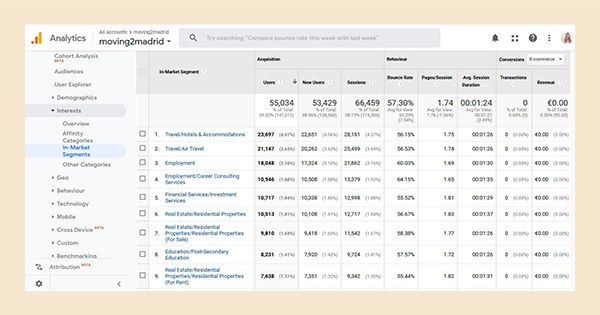
It is important to note that although these percentages are small, we can draw accurate conclusions from them by looking for commonalities. All of the above product searches appear to have been conducted by people that are planning on relocating- some of them with families. Which is true: these results are from a client of mine that runs a property search firm for expats.
Now, let’s look at Number 10 on the In-Market Segment report. 1.21% are searching on business productivity software. This tells us that a lot of their web traffic comes from people that own their own business.
You can use the above information to create your buyer personas. Using the above data, we learn that this client’s web traffic comes from people with the following demographics:
‣ They are both male and female.
‣ Their primary age bracket is 25-34, followed by 35-44.
‣ They are based in Spain, the US and the UK.
‣ Many of them own their own businesses.
But we still need a little more information.
Step 5
Our third hack is to analyze your social media accounts to learn more about your customers. Head over to Facebook and look at your business reviews. View the Facebook pages and other social media accounts of people that gave you good reviews.
Do the same for people that gave you good reviews on Yelp. From these, look at the commonalities of these customers. Use this information to go through the steps above and put together 3-4 buyer personas for your business.
Takeaways
- Buyer Personas are fictional characters you create to help you understand, and empathize with, your customers.
- Small business owners have an advantage in that they often have close contact with their customers. If this is the case, you can use your biggest customers as buyer personas.
- When you finish this module, you will have buyer personas for people that buy your different products and services. Start by focusing on your biggest line of business and work your way down.

Do you need help using Google Analytics? Or are your buyer personas not straightforward? You can use one of your free vouchers to book a call with Mary Clare and she will be happy to help!


